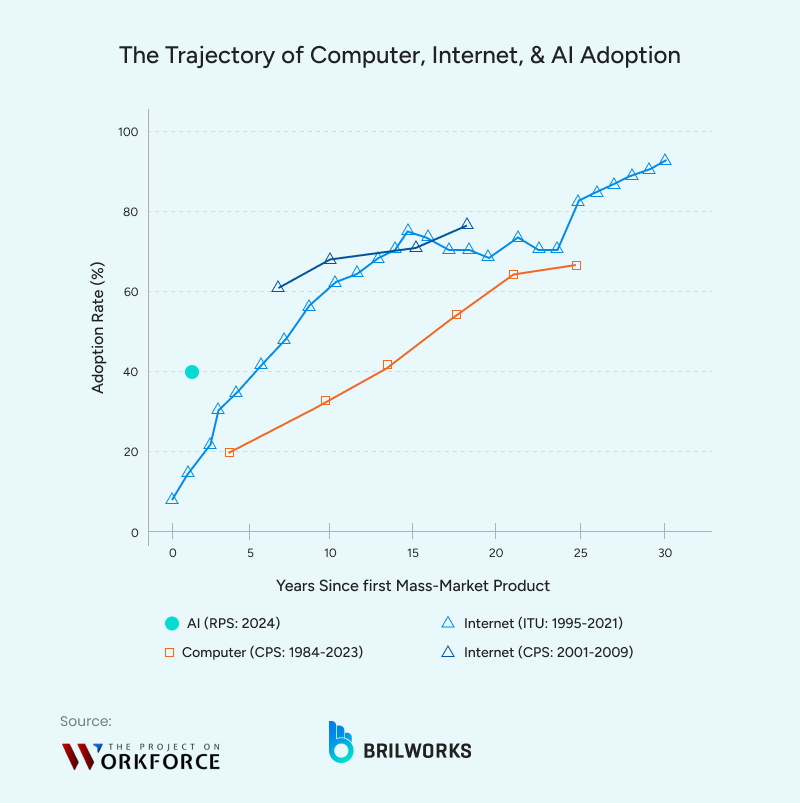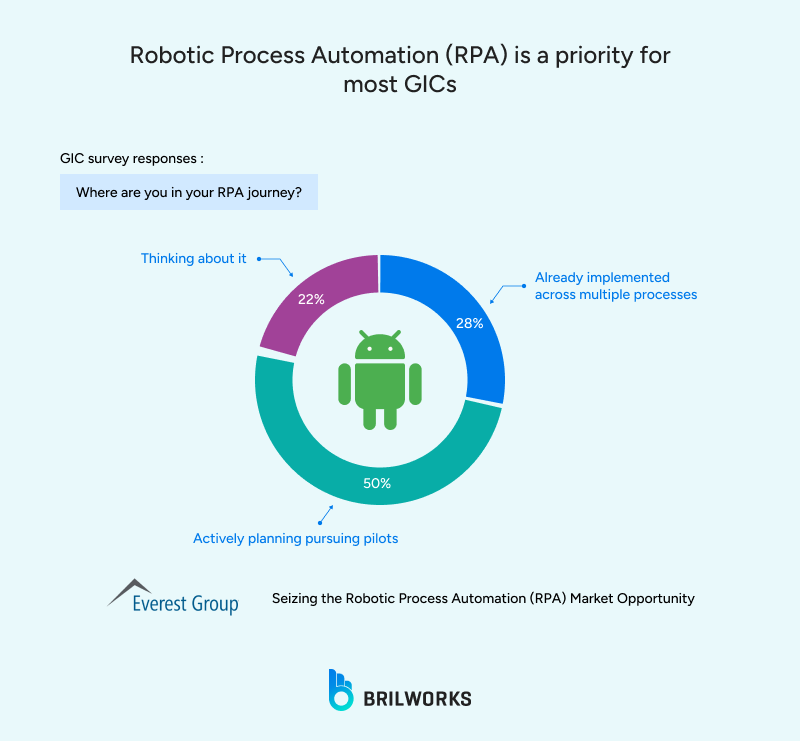COOPERATION MODEL
ARTIFICIAL INTELLIGENCE
PRODUCT ENGINEERING
DevOps & Cloud
LOW-CODE/NO-CODE DEVELOPMENT
FRONTEND DEVELOPMENT
CLOUD DEVELOPMENT
MOBILE APP DEVELOPMENT
LOW CODE/ NO CODE DEVELOPMENT
EMERGING TECHNOLOGIES








As technologies like AI keep advancing rapidly, the software development space is shifting with them. The rise of intelligent systems is pulling almost every part of IT into a new direction. Computing power has jumped. Data processing is smoother for large organizations.
AI agents, generative models, and automation aren’t experimental anymore and within reach of small companies. Understanding them is necessary if you want to know where software is heading next. Below are the popular software development industry trends in 2025.
It’s been around three years since generative AI went mainstream, and since then, AI applications across different industries have been growing. It is today a $390 billion market, surging at 19% CAGR. AI-driven development tools, including IDEs, have spread across almost every part of software development. Industries have started using AI in their day-to-day operations, including:
AI-driven development tools, including IDEs, have spread across almost every part of software development. Industries have started using AI in their day-to-day operations, including:
Fintech uses it for fraud detection,
Healthcare uses it for automation and monitoring,
Product teams use it to speed up development, testing, and debugging.
Personalization, which used to be complicated and resource-heavy for companies with limited resources, is now doable without huge engineering efforts.
Robotic Process Automation (RPA) is also rising.  More than half of businesses are using some form of RPA already, and another chunk is planning to adopt it in the next two years.
More than half of businesses are using some form of RPA already, and another chunk is planning to adopt it in the next two years.
Tools like Cursor, Laval, Windsurf, and other AI-powered coding assistants are becoming the new normal across businesses of all sizes.
AI Adoption Across Different Industries
Generative AI (63%) adoption now aligns with traditional AI (62%), acting as the primary investment catalyst.
Large enterprises (LEs) lead, projecting to hold a 59.0% share in the AI-Based Data Observability market. SMEs lag due to high infrastructure costs and a severe talent shortage where AI developer salaries are 44% higher.
The financial sector's RegTech market, driven by mandatory compliance, is projected to grow at a high Compound Annual Growth Rate (CAGR) of 20.62% by 2035.
The Asia Pacific region leads adoption, with China advancing at a 15.3% CAGR and India at 14.1%, fueled by cloud and analytics maturity.
66% of organizations in EMEA have realized notable operational productivity improvements. The top areas for gains are Software Development/IT (32%) and Customer Service (32%).
People keep debating this, but with AI, low-code, and no-code development is accelerating. It is growing even faster than before. Building custom software is expensive, and no-code platforms give them a way to build basic or mid-level products without huge engineering budgets. The LCNC tools' popularity has exploded by more than 200% in the last five years.
These tools help two types of users:
Citizen developers: Project managers, business owners, teams that need quick solutions.
Specialized developers: They use low-code tools as shortcuts to speed up routine or repetitive work.
Platforms like Adalo, Bubble, FlutterFlow, and others have all raised decent VC funding, which shows investor confidence. Gartner notes that more than half of medium to large companies use some form of low-code or no-code platform.
The global LCNC market is projected to surge from $13.2 billion (2020) to up to $264.40 billion by 2032.
By 2025/2026, LCNC is expected to be responsible for 65% to 75% of all new application development activity.
LCNC directly addresses the global developer shortage, reducing app development time by up to 90% (Citizen Dev) and 50% (Pro Dev), thus shrinking the IT backlog.
Applications created using LCNC yielded a business value improvement of approximately $4.4 million over three years per organization, partly by avoiding the hiring of two IT developers.
LCNC enables Line-of-Business (LoB) units to directly automate workflows, accelerating digital transformation. It facilitates 40% to 50% faster remediation of technical debt.
41% of companies have active citizen development programs. By 2026, 80% of LCNC application users are forecasted to be outside IT.
App development costs in 2025 are skyrocketing. App stores are competitive, and users don’t want to download an app for every business. PWAs work like a win-win solution for developers and end-users.
Progressive Web Apps sit between a website and an app. You get an app-like experience without forcing people into the App Store or Play Store. Companies are turning to PWAs because:
They’re lightweight (often 90–95% smaller than a native app),
They load fast,
They work offline or semi-offline,
They improve user experience without full-scale app development.
Progressive Web Applications Insights
PWA development is 3 to 8 times cheaper than building separate dual-platform native applications, with maintenance costs approximately 33% lower.
PWAs leverage the more cost-effective web stack, avoiding the 35% to 45% salary premium commanded by specialized native developers.
PWAs are superior conversion tools.
Unlike native apps, PWAs are indexable by search engines.
Microservices are a flexible way to build systems of any size without being trapped in a monolithic architecture. Netflix and Amazon popularized it, and the industry followed. But now the trend is turning.
Even Amazon moved parts of their system back to a more consolidated architecture because managing too many microservices became complicated, expensive, and slow. Microservices still work for some cases, but they’re no longer the automatic choice. Teams are going back to simpler architectures to improve performance and reduce operational overhead.
Blockchain was once seen as only crypto-focused, but it’s now making its way into software systems across industries. The market is expected to reach around $290 billion by 2030.
Blockchain-based systems are extremely secure. Data is decentralized and replicated, making it harder to breach or manipulate.
That’s why industries like healthcare, software, logistics, and others are exploring blockchain for secure data handling. Around 73% of executives believe blockchain can give them a competitive edge.
AI is driving the biggest shift right now. It’s changing how teams develop software, how products are built, and even how products are marketed. PWAs are rising in parallel, while microservices, once the default modernization path, are no longer the universal answer. Too many teams hit orchestration issues, scaling problems, and unnecessary complexity, so the model isn’t working for everyone anymore.
In 2025, AI sits at the center of everything. Whether people call it a bubble or the next reality, the impact is visible. The narrative about AI replacing a big portion of the workforce might sound exaggerated, but the direction is clear: large companies are investing heavily in building powerful AI infrastructure instead of expanding human teams. That shift is already happening.
And this won’t slow down in 2026. The momentum is too strong. AI is reshaping development strategies, tooling choices, and how digital operations run at scale. The next phase of software development will be defined by how fast teams adapt to this new AI-driven environment.
Get In Touch
Contact us for your software development requirements
Get In Touch
Contact us for your software development requirements